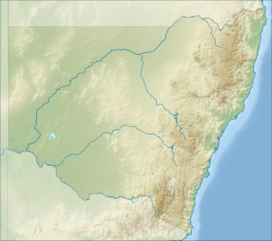| Revision as of 13:34, 23 November 2012 editRussBot (talk | contribs)Bots1,406,952 editsm Robot: Editing intentional link to disambiguation page in hatnote per WP:INTDABLINK (explanation)← Previous edit | Revision as of 14:58, 12 February 2013 edit undoJustAGal (talk | contribs)Autopatrolled, Extended confirmed users, Pending changes reviewers, Rollbackers172,788 edits →See also: disambigNext edit → | ||
| Line 34: | Line 34: | ||
| ==See also== | ==See also== | ||
| *] | *] | ||
| *] | *] | ||
Revision as of 14:58, 12 February 2013
This article is about the hill from which gold was mined. For the hill made of granite, see Gibraltar Hill.| Gibralter Hill | |
|---|---|
 | |
| Geography | |
| Region | AU |
Gibralter Hill (also known as Gibraltar Hill) is a hill near Grahamstown, New South Wales, Australia.
Gold mining
In one week in April, 1864, almost 550 ounces of gold were mined from Gibralter Hill, a yield of more than 58 ounces per ton of ore. In 1893 the Gibraltar Gold Mining Company exhibited gold ore from the hill at the World's Columbian Exposition in Chicago yielding a net of 6 ounces of gold per ton.
In 1894 the Gibraltar Hill Company took 656 tons of ore from the hill, which yielded 2090 ounces of gold. In 1895 more than 1500 ounces of gold were mined from the hill by the Gibraltar Gold Mining Company, although by this time the yield was down to less than 5 ounces per ton of ore.
See also
References
- "Geographical Names Register Extract". Geographical Names Board of New South Wales. New South Wales Government. Retrieved 5 November 2012.
- Dicker's Mining Record, and Guide to the Gold Mines of Australia. 1864. p. 68. Retrieved 3 November 2012.
- New South Wales. Commissioners for the World's Columbian exposition (1893). Catalogue of New South Wales exhibits. Charles Potter. p. 241. Retrieved 3 November 2012.
- Journal of the New South Wales Parliament Legislative Council. 1894. p. 22. Retrieved 5 November 2012.
- New South Wales. Dept. of Mines; Geological Survey of New South Wales (1895). Annual report - New South Wales Department of Mines. New South Wales Department of Mines. p. 75. Retrieved 3 November 2012.
This New South Wales geography article is a stub. You can help Misplaced Pages by expanding it. |